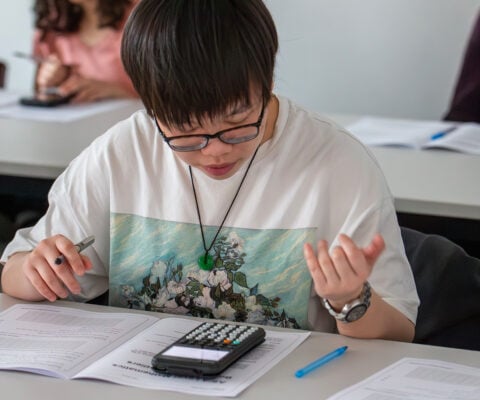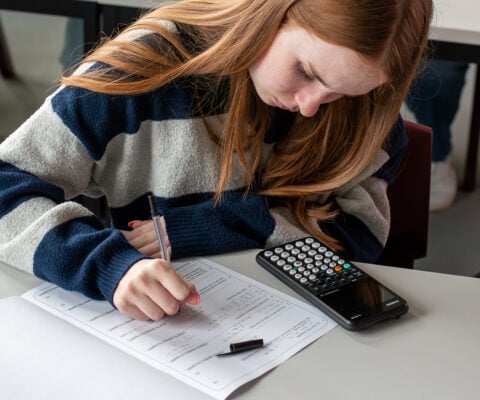Mastering A-level maths topics: a blueprint for smarter study
We explore some key A-level maths topics, common challenges and revision tips to help you get to grips with both pure and applied maths.

Getting your head around the many topics and concepts that make up the A-level maths syllabus is a big challenge that requires a serious step up from GCSE.
There’s always support available to help you manage this transition, primarily from your teacher and school, but from other sources too. In this article, we take a close look at:
● What makes A-level maths significantly harder than GCSE
● Some of the central pillars of learning A-level maths
● Fundamental A-level maths topics that much of your work will be based on
● Challenging topics that lots of students struggle with
● Learning and revision resources to help you navigate the syllabus

Why A-level maths feels so tough
The jump from GCSE to A-level maths is a big one, and many students are surprised by how quickly the subject ramps up in complexity.
Concepts become more abstract, requiring sharper logical reasoning and a deeper understanding of mathematical theory. One of the biggest challenges is juggling A-level pure maths topics – like algebra and calculus – and applied maths, which includes mechanics and statistics. These areas demand different skill sets and ways of thinking.
When you make the transition to A-level, you’ll also find there’s a greater emphasis on multi-step problem-solving, which can involve drawing on your knowledge of different topics.
On top of the above, there is simply a larger volume of content to get through in A-level maths, which means the pace of work increases significantly.
So what are the best ways to deal with these difficulties and work efficiently as you progress through the course?

The pillars of learning A-level maths
A highly structured and organised approach is likely to prove crucial if you want to succeed in years 12 and 13.
You might find it helpful to view your A-level maths learning through the lens of these pillars:
● Conceptual understanding: Working with your teacher to grasp not just how a method works, but why it works, can lead to deeper, long-term comprehension.
● Procedural practice: Consistent repetition of core question types helps you improve your speed and accuracy.
● Inter-topic connections: Recognising how algebra underpins calculus, or how trigonometry links to mechanics, for example, can reinforce understanding across the syllabus.
● Exam application: Working through past papers and analysing mark schemes helps you apply your knowledge under timed conditions and build familiarity with exam expectations.
Foundational topics in A-level maths
A-level maths relies on some core foundations, which you’ll have started studying at GCSE and will need to be highly familiar with as you progress into years 12 and 13. Let’s look at some of the most important ones.

Algebra
Algebra is the language of A-level maths. You’ll do a lot of work with quadratic and cubic equations, functions, indices, surds and algebraic manipulation.
You’ll also be introduced to proof, binomial expansions and mathematical modelling – all of which rely heavily on algebraic reasoning.

Trigonometry
Trigonometry goes well beyond SOH CAH TOA at A-level. The course includes lots of content on radians, sine and cosine rules, trigonometric identities and graphs.
These concepts are used throughout the pure maths syllabus and often appear in mechanics when dealing with vectors and motion.
Link to ‘A-level trigonometry identities’ blog

Graphs and functions
A-level maths places a major emphasis on functions and their graphs. The syllabus encompasses various types of functions – including linear, quadratic, exponential and logarithmic – and how to draw and interpret their graphs.
Understanding how function transformations affect graphs is key, as this links closely to solving equations and modelling real-world scenarios, which comes up a lot in exam questions.

Tackling the trickiest A-level maths topics
There are certain A-level maths and further maths topics that trip up the majority of students and require a lot of focus, hard work and savvy calculator use to unpack.
● Integration can feel less systematic than differentiation and often requires pattern recognition. You might find it useful to view it as the reverse of differentiation and to practise finding areas under curves using different types of questions.
● Proof is an abstract and unfamiliar topic for many A-level maths students, especially when dealing with logical reasoning rather than working with numbers. Consider starting with simple algebraic proofs and remember to always lay out each step clearly.
● Hypothesis testing combines statistics and probability with written interpretation, which can be challenging. It requires an understanding of the logic behind null and alternative hypotheses and lots of practice explaining your conclusions in context.
● Vectors are an advanced aspect of further maths that involve direction, magnitude and sometimes 3D thinking. Working through geometric problems visually can help make this topic feel more approachable.

Revision tips and resources for A-level maths
Effective revision strategies, resources and techniques will prove hugely valuable as you progress through your A-level maths course and start preparing for exams.
Here are some suggestions you may find useful:
● Combine topic clusters: Studying related topics together – like algebra and sequences, vectors and mechanics, or probability and statistics – can reveal how concepts interact across the syllabus and builds deeper understanding.
● Use worked examples and visual notes: Revising with step-by-step worked examples can be highly beneficial in pure maths. You might want to annotate your notes with colour, diagrams and flowcharts to break down complex concepts and processes.
● Draw diagrams in mechanics: Sketching forces, motion paths and vectors can help with visualising the problem and setting up equations correctly. This can have advantages in terms of both understanding and exam marks.
● Apply stats to real-world data: Practising with real data sets can bring statistics to life and help you make sense of probability distributions and hypothesis tests.